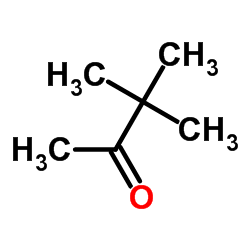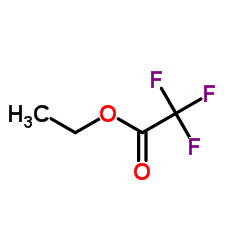1,1,1-trifluoro-5,5-dimethyl-2,4-hexanedione

1,1,1-trifluoro-5,5-dimethyl-2,4-hexanedione structure
|
Common Name | 1,1,1-trifluoro-5,5-dimethyl-2,4-hexanedione | ||
|---|---|---|---|---|
| CAS Number | 22767-90-4 | Molecular Weight | 196.16700 | |
| Density | 1.129 g/mL at 25 °C(lit.) | Boiling Point | 138-141 °C(lit.) | |
| Molecular Formula | C8H11F3O2 | Melting Point | 68-71 ℃/6mm | |
| MSDS | Chinese USA | Flash Point | 105 °F | |
| Symbol |

GHS02 |
Signal Word | Warning | |
Use of 1,1,1-trifluoro-5,5-dimethyl-2,4-hexanedione |
| Name | 1,1,1-trifluoro-5,5-dimethylhexane-2,4-dione |
|---|---|
| Synonym | More Synonyms |
| Density | 1.129 g/mL at 25 °C(lit.) |
|---|---|
| Boiling Point | 138-141 °C(lit.) |
| Melting Point | 68-71 ℃/6mm |
| Molecular Formula | C8H11F3O2 |
| Molecular Weight | 196.16700 |
| Flash Point | 105 °F |
| Exact Mass | 196.07100 |
| PSA | 34.14000 |
| LogP | 2.12310 |
| Vapour Pressure | 0.806mmHg at 25°C |
| Index of Refraction | n20/D 1.407(lit.) |
| Storage condition | Flammables area |
| Symbol |

GHS02 |
|---|---|
| Signal Word | Warning |
| Hazard Statements | H226 |
| Personal Protective Equipment | Eyeshields;Faceshields;full-face respirator (US);Gloves;multi-purpose combination respirator cartridge (US);type ABEK (EN14387) respirator filter |
| Hazard Codes | C: Corrosive; |
| Risk Phrases | R10 |
| Safety Phrases | S16 |
| RIDADR | UN 1224 3/PG 3 |
| WGK Germany | 3 |
| Packaging Group | III |
| Hazard Class | 3 |
| HS Code | 2914700090 |
|
~% 
1,1,1-trifluoro... CAS#:22767-90-4 |
| Literature: Journal of the American Chemical Society, , vol. 75, p. 2446 |
| HS Code | 2914700090 |
|---|---|
| Summary | HS: 2914700090 halogenated, sulphonated, nitrated or nitrosated derivatives of ketones and quinones, whether or not with other oxygen function Tax rebate rate:9.0% Supervision conditions:none VAT:17.0% MFN tariff:5.5% General tariff:30.0% |
|
A new sequencing approach for N-unsubstituted heparin/heparan sulfate oligosaccharides.
Glycobiology 25 , 714-25, (2015) The rare N-unsubstituted glucosamine (GlcNH(3)(+)) residues in heparan sulfate (HS) have important biological and pathophysiological roles. Because of their low natural abundance, the use of chemicall... |
|
|
ROP and ATRP Fabricated Dual Targeted Redox Sensitive Polymersomes Based on pPEGMA-PCL-ss-PCL-pPEGMA Triblock Copolymers for Breast Cancer Therapeutics.
ACS Appl. Mater. Interfaces 7 , 9211-27, (2015) To minimize cardiotoxicity and to increase the bioavailability of doxorubicin, polymersomes based on redox sensitive amphiphilic triblock copolymer poly(polyethylene glycol methacrylate)-poly(caprolac... |
|
|
Mechanism of scrapie prion precipitation with phosphotungstate anions.
ACS Chem. Biol. 10 , 1269-77, (2015) The phosphotungstate anion (PTA) is widely used to facilitate the precipitation of disease-causing prion protein (PrP(Sc)) from infected tissue for applications in structural studies and diagnostic ap... |
| 2,4-Hexanedione,1,1,1-trifluoro-5,5-dimethyl |
| 5,5-dimethyl-1,1,1-trifluoromethylhexane-2,4-dione |
| 1,1,1-Trifluoro-5,5-dimethyl-2,4-hexanedione |
| 6,6,-trifluoro-2,2,-dimethyl-3,5-hexanedione |
| 6,6,6-trifluoro-2,2-dimethylhexanedione-3,5 |
| 5,5-dimethyl-1,1,1-trifluorohexane-2,4-dione |
| EINECS 245-211-0 |
| Pivaloyltrifluoroacetone |
| MFCD00040841 |
| 1,1,1-trifluoro-5,5-dimethyl-2,4-hexanedionate |


 CAS#:6832-15-1
CAS#:6832-15-1 CAS#:76-05-1
CAS#:76-05-1